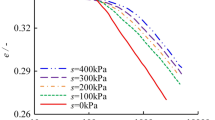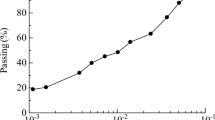Abstract
Cracks initiate and propagate when tensile stress, caused by an increase in suction, becomes greater than tensile strength in expansive soils. It is important to understand the variation of tensile stress with suction for properly tackling the problems associated with cracks. In this paper, a new practical model is presented for predicting tensile stress from suction, and is verified using finite element analysis. The parametric study shows that drying time and diffusion coefficient control the distribution of tensile stress with depth and the depth to zero tensile stress, while elastic modulus, the difference between final surface suction and initial suction, and suction compression index control the magnitude of tensile stress. The new model can be used to predict the suction where the crack initiates using the soil water characteristic curve (SWCC), to estimate the depth of crack for a specific region, and to estimate the required drying time for a specific crack depth. The new model widens the general application of the SWCC approach in unsaturated soils and can be a useful tool to analyze the interaction between foundation or pavement subgrade and local climatic conditions.






Similar content being viewed by others
References
Abou Najm M, Mohtar RH, Weiss J, Braudeau E (2009) Assessing internal stress evolution in unsaturated soils. Water Resour Res 45(5):1–18
Aubeny C, Lytton RL, Tang D (2003) Simplified analysis of moisture flow through unsaturated soil. Transp Res Rec J Transp Res Board 1821:75–82
Barzegar AR, Oades JM, Rengasamy P, Murray RS (1995) Tensile strength of dry, remoulded soils as affected by properties of the clay fraction. Geoderma 65:93–108
Carslaw HS, Jaeger JG (1959) Conduction of heat in solids. Calderon Press, Oxford
Chen L (2015) Development of a new tensile stress model for expansive soils Dissertation. Oklahoma State University, Oklahoma
Chertkov VY (2002) Modelling cracking stages of saturated soils as they dry and shrink. Eur J Soil Sci 53:105–118
Covar AP, Lytton L (2001) Estimating soil swelling behavior using soil classification properties. ASCE Geotechnical Special Technical Publication, New York, p 115
Fang HY, Chen WF (1971) New method for determination of tensile strength of soils. Highw Res Rec 375:62–68
Fredlund DG, Rahardjo H (1993) Soil mechanics for unsaturated soils. Wiley, Hoboken
Fredlund DG, Sheng D, Zhao J (2011) Estimation of soil suction from the soil-water characteristic curve. Can Geotech J 48(2):186–198
Gerscovich DMS, Sayao ASFJ (2002) Evaluation of the soil–water characteristic curve equations for soils from Brazil. In: Third international conference on unsaturated soils—UNSAT2002, março, Recife, vol 1, pp 295–300 (ISBN 90 58093727)
Gomesa AT, Fonsecab AVD, Cardoso AS (2011) Soil water characteristic curve for a granite residual soil: experimental and numerical results. Defect Diffus Forum 312–315:1172–1177
Harry GP, Edward HD (1974) Elastic solutions for soil and rock mechanics. Wiley, Hoboken (ISBN-10: 0471695653)
Konrad JM, Ayad R (1997) Desiccation of a sensitive clay: field experimental observations. Can Geotech J 34:929–942
Lai WM, Rubin D, Krempl E (2009) Introduction to continuum mechanics, 4th edn. Elsevier, Amsterdam (ISBN-10: 0750685603)
Lu N (2014) Power law for elastic moduli of unsaturated soil. J Geotech Geoenviron Eng 140:46–56
Lu N, Likos WJ (2004) Unsaturated soil mechanics Technology and Engineering. Wiley, New York (ISBN: 978-0-471-44731-3)
Luo R (2007) Minimizing longitudinal pavement cracking due to subgrade shrinkage. Dissertation. University of Texas-Austin, Austin
Luo R, Prozzi JA (2009) Combining geogrid reinforcement and lime treatment to control dry land longitudinal cracking. Transp Res Rec J Transp Res Board 2104:88–96
Lytton RL, Aubeny C, Bulut R (2005) Design procedure for pavements on expansive soils, Report No. FHWA/TX-05/0-4518-1, vol 1. Texas Transportation Institute, The Texas A&M University System, College Station, p 198
Mitchell PW (1979) The structural analysis of footings on expansive soil. Kenneth W.G. Smith and Associates Research Report No. 1. Webb & Son, Adelaide, p 152
Nuhfer EB, Proctor RJ, Moser N (1993) The citizen’s guide to geologic hazards. AIPG Press, Arvada
Oh WT, Vanapalli SK (2011) Relationship between Poisson’s ratio and soil suction for unsaturated soils. Unsaturated Soils Theory Pract 2011:239–245
Sih GC, Michopoulos JG, Chow SC (1968) Hygro-thermo-elasticity. Martinus Njihoff Publishers, Leiden
Sumarac D (2004) Moisture diffusion induced soil cracking. In: The first international conference on computational mechanics (CM’04), Belgrade, Serbia and Montenegro
Varsei M, Bourasset C M, Miller GA (2014) Laboratory investigation of desiccation cracking. Geo-Congress 2014 Technical Papers, GSP 234, ASCE 2014
Venkataramana K, Rao BH, Singh DN (2009) A critical review of the methodologies employed for determination of tensile strength of the fine-grained soils. J Test Eval 37:115–121
Wray WK, Meyer KT (2004) A widespread and costly geohazard. Geostrata. ASCE GeoInst 5(4):24–28
Zeh RM, Witt KJ (2005) Suction-controlled tensile strength of compacted clays. In: Proceedings of 16th international conference soil mechanical geotechnical engineering, vol 4, Osaka, Japan, pp 2347–2352
Author information
Authors and Affiliations
Corresponding author
Rights and permissions
About this article
Cite this article
Chen, L., Bulut, R. Development and Application of a New Tensile Stress Model for Expansive Soils. Geotech Geol Eng 35, 1067–1077 (2017). https://doi.org/10.1007/s10706-017-0163-6
Received:
Accepted:
Published:
Issue Date:
DOI: https://doi.org/10.1007/s10706-017-0163-6




